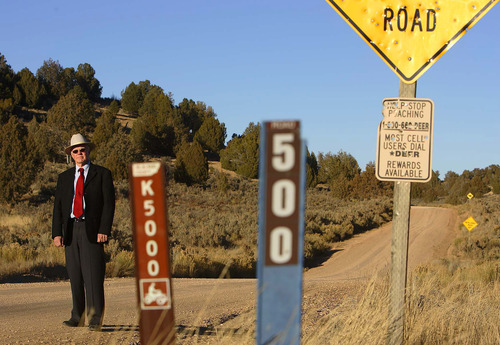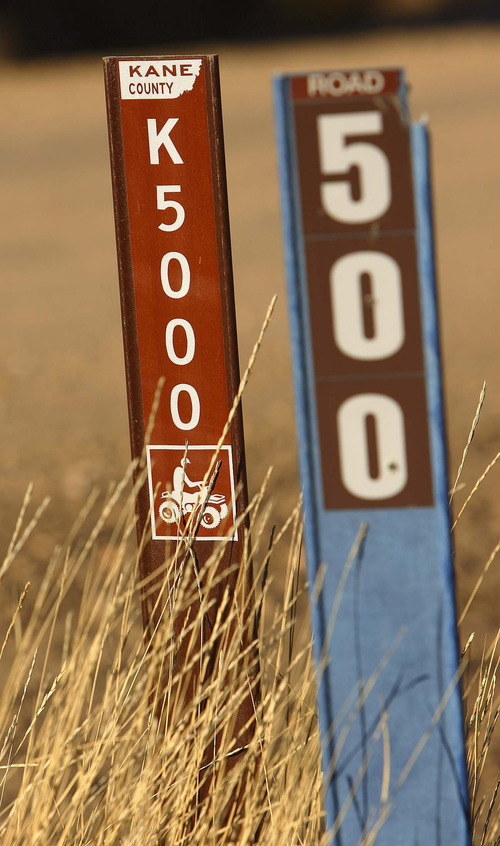This is an archived article that was published on sltrib.com in 2013, and information in the article may be outdated. It is provided only for personal research purposes and may not be reprinted.
A federal judge handed a landmark victory to Kane County and the state of Utah on Wednesday in a years-long dispute with the federal government over whether some rural routes should remain in use as roads, or if they should be closed to the public.
In two decisions, U.S. District Judge Clark Waddoups found he had jurisdiction to hear Kane County's claim, gave parameters for "reasonable" right-of-way widths on some routes and determined that 12 of 15 routes in dispute were roads and therefore accessible by the public.
The distinction hinged on an 1866 law through which Congress sought to encourage development by allowing local jurisdictions to manage routes across public lands; the law was repealed in 1976 by Revised Statute 2477.
With the revision, Congress retained most remaining public lands and created the Bureau of Land Management. Pre-existing claims, however, were grandfathered in and considered valid as long as entities moved to claim them within a 12-year time frame. Waddoups determined that Kane County did so.
Kane County Commission Chairman Doug Heaton said Thursday the ruling vindicates the county in its fight to continue to travel what he described as historic thoroughfares.
"We're confident the judge took great pains to get it right," he said. "We're excited the court has ruled in our favor."
Utah Gov. Gary Herbert and Attorney General John Swallow also hailed the decision, which Swallow said shows "these historic public roads have and will continue to belong to the people of Utah."
Swallow said the federal government's refusal to recognize the routes as state and county roads had "damaged the economy and put motorists at risk" by impeding routine maintenance.
Melodie Rydalch, spokeswoman for the U.S. Attorney's Office, said the office was reviewing the decision and would not have further comment.
Heaton said the roads in question were in use for at least 10 years before 1976, and in some cases date back to the late 1800s. Kane County is made up of 65 percent federal land, Heaton said. "In order to access the public resources on these lands, you have to travel these roads."
The legal battle was a "significant burden" financially, he said. "This is a tremendous vindication. We are simply reasserting the public's rights to travel these roads."
Of the 12 routes deemed roads, four are in the Grand Staircase-Escalante National Monument. The rest are on land managed by the Bureau of Land Management's Kanab office. Waddoups traveled all of the disputed routes with attorneys in the case over two days in December 2010. He presided over a trial in the case in August 2011 and took additional testimony in January 2012.
Waddoups heard from county workers and local residents about how each route was used prior to 1976 and then how most were maintained later by the county.
Waddoups noted, for example, that Upper Mill Creek was used prior to 1976 for "the apparent purposes of gathering firewood, cutting cedar posts, hunting and scouting for deer, gathering pine nuts, and general sightseeing."
One Kane County rancher recounted local lore of how John D. Lee cut timber and operated a saw mill in the area in the late 1800s, which led to the route's name. Similar uses were declared for most of the other disputed routes.
The state and 22 of Utah's 29 counties have filed more than 20 lawsuits laying claim to more than 12,000 rights-of-way on public land.
"This tsunami of litigation threatens several national parks and monuments as well as iconic Utah wilderness landscapes," said Steve Bloch, litigation director for the Southern Utah Wilderness Alliance in an email. SUWA had filed an amicus brief in the case that focused primarily on whether Kane County asserted its claims in a timely manner.
An appeal of the decision is likely, said David Garbett, SUWA attorney.
Garbett said Utah and the counties were relying on RS 2477 to claim "dirt trails, cow paths and roads to nowhere as highways."
"While undoubtedly some of these claims do encompass well-used and traveled and vital roads, those are roads no one is fighting over," Garbett said, but others are indistinct paths and meandering washes in critical wilderness quality lands.
The fight, he said, could complicate wilderness designations if cow paths are determined to be roads. "It's largely about land control and wilderness," Garbett said.
Christopher Smart contributed to this story.





